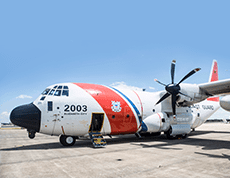As early as 2013 the Coast Guard recognized that the legacy processors in its fixed wing aircraft assets would be unable to run the updated systems needed for optimal mission execution. After careful consideration, the Minotaur mission system architecture was chosen to upgrade and replace the legacy systems.
Minotaur integrates sensors; radar; command, control, communications, computers, intelligence, surveillance and reconnaissance equipment and enables aircrews to gather and process surveillance information that can be transmitted to other platforms and units during flight. The system is open government-owned which enables the Coast Guard to have more control over upgrades, take advantage of Department of Defense logistics, spare parts and keep the cycle cost down.
The Coast Guard worked with the Naval Air Systems Command to develop Minotaur to meet Coast Guard mission requirements, and the Coast Guard’s Minotaur Mission System Integration Lab at Naval Air Station Patuxent River, Maryland lead the development and integration work. Prototype installation for all aircraft began at Patuxent River.
The Coast Guard initiated a major overhaul of its fixed wing airborne reconnaissance aircraft capabilities.in July 2015. A firm fixed-price contract was awarded to incorporate the next-generation Minotaur Mission System Suite on two baseline C-130J long range surveillance aircraft to L-3 Communications Integrated Systems Platform Integration Division in Waco, Texas. The five-year contract included multiple options to perform the same work on three additional baseline configuration aircraft and conversion of seven HC-130J aircraft that are currently performing Coast Guard missions with the legacy mission system. Total value of the contract, including all options, is approximately $93 million.

The first aircraft in the Coast Guard fleet outfitted with Minotaur, CGNR 2003, was inducted into the mission system modification process in July 2015 and began test flights in June 2016. CGNR 2003 was delivered to the fleet in June 2017. The retrofit of all legacy C-130Js was completed in September 2019.
The Coast Guard’s HC-130J long range surveillance aircraft provide heavy air transport and long-range maritime patrol capability. Each aircraft is capable of serving as an on-scene command and control platform or as a surveillance platform with the means to detect, classify and identify objects and share that information with operational forces.

The first Minotaur HC-144B, CGNR 2307, was delivered to the fleet in July 2017. HC-144B Minotaur production began at the Aviation Logistics Center (ALC) in Elizabeth City, North Carolina, in October 2017. The 2307 received a separate Ocean Sentry Refresh B Model Upgrade which updated the aircraft’s avionics. and expanded the extensive sensor capability The Coast Guard combined the Minotaur system and the Ocean Sentry Refresh modifications into one conversion process in fiscal year 2018. The term missionized is used to define this process.

The Coast Guard upgraded and integrated 14 C-27Js into its medium range surveillance aircraft fleet to perform drug and migrant interdiction, disaster response, and search and rescue missions. The Minotaur mission system. integration was installed. The first C-27J was missionized at Patuxent River in October, 2017. The Coast Guard estimated that the HC-27J fleet would be completely missionized by the end of 2021.
Minotaur provides a significant increase in Coast Guard operational capabilities. By linking sensors, cameras, radar and communications equipment into a single, more automated system, operators are able to more efficiently identify and track any suspicious or illegal activity on both land and sea. The same features are advantages for Search and Rescue operations.
Among Minotaur’s important features, operators can replay anything on the screen and returning crews can show the next crew exactly what they accomplished and where to continue the reconnaissance. With the current software, that information is lost as soon as the equipment is shut down. Through a satellite link, Minotaur provides text communications, an especially useful feature that does not require a line-of-sight signal.

